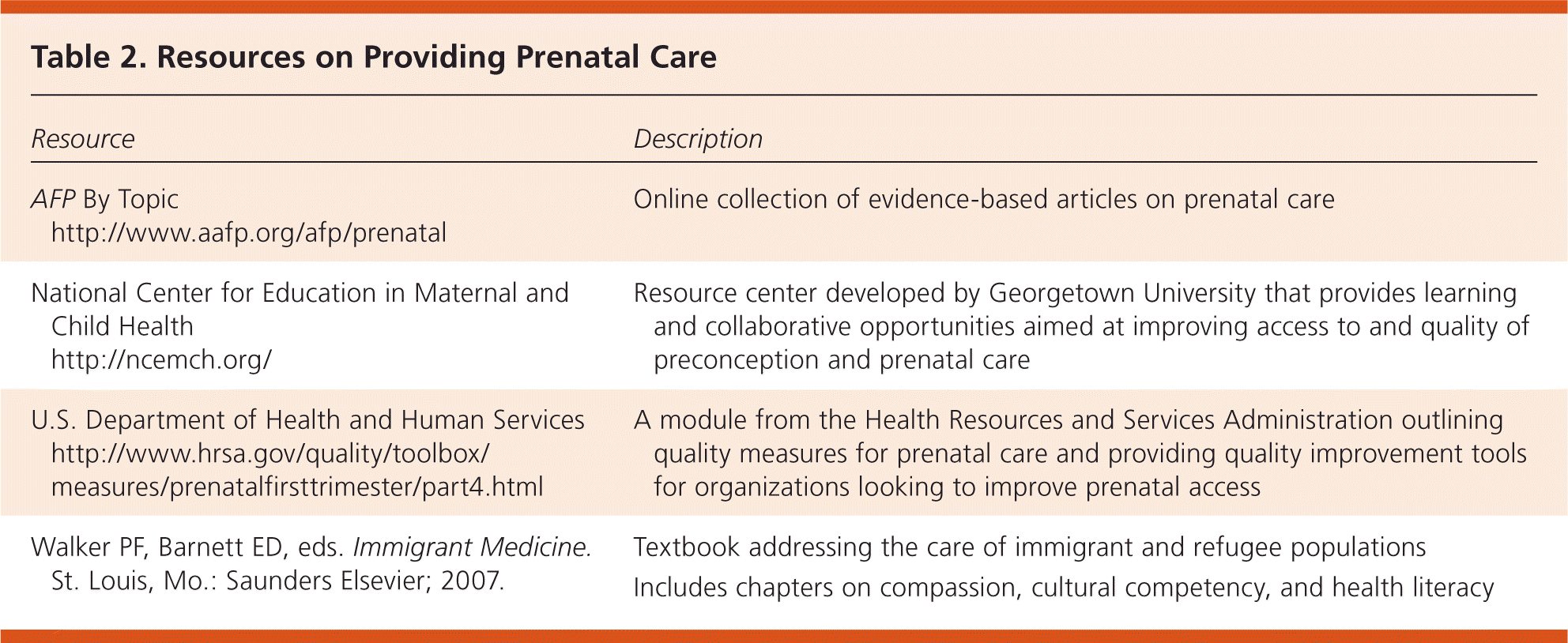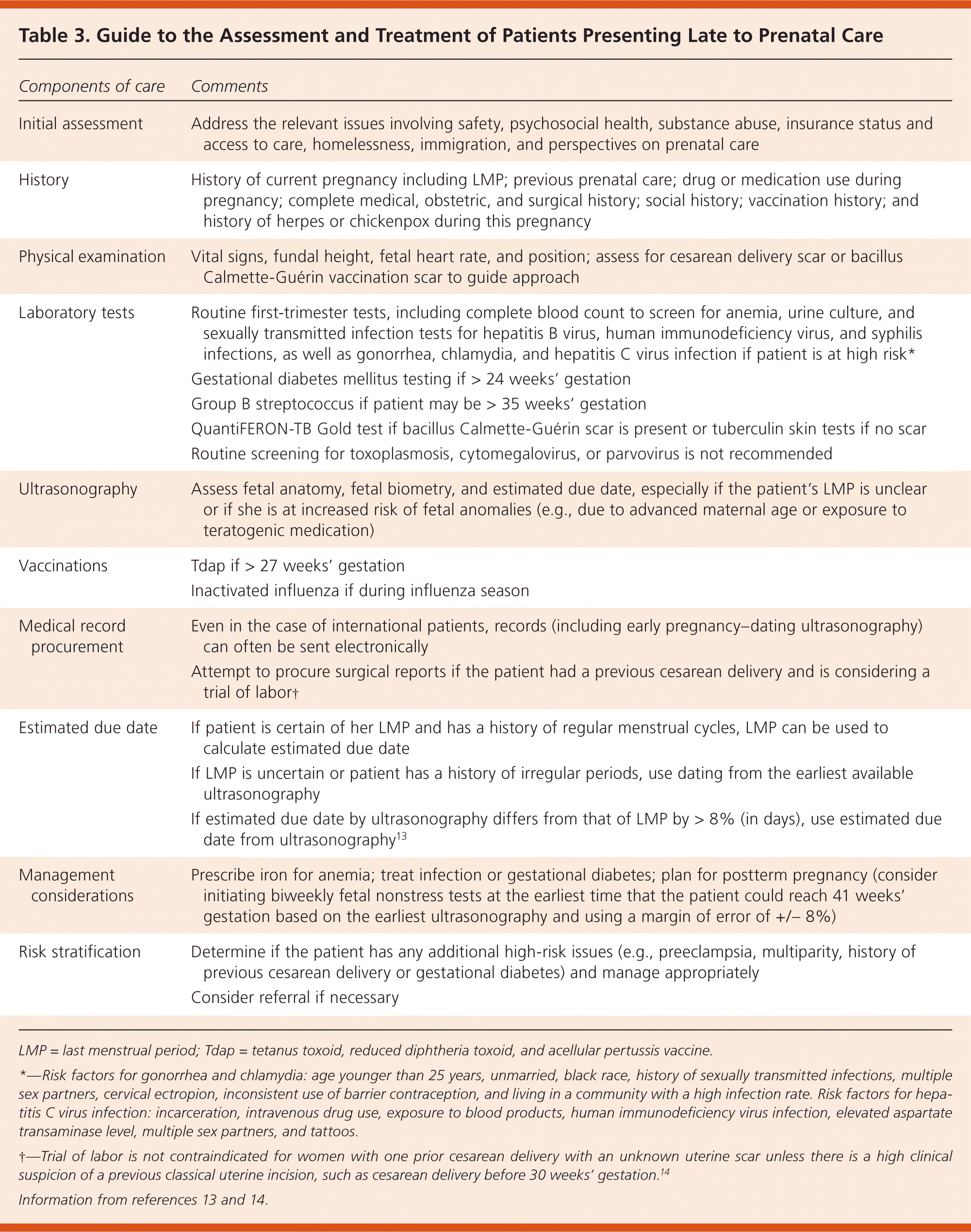
Am Fam Physician. 2015;92(5):391-397
Author disclosure: No relevant financial affiliations.
Case Scenario
A 26-year-old gravida 2, para 1 Dominican woman presents to my clinic for a prenatal visit. She is unsure of her due date and states that her last menstrual period was about seven or eight months ago. She received some prenatal care in the Dominican Republic, although she does not have any records from her physician. She reports that she has had an uncomplicated pregnancy so far, and that an earlier ultrasonography indicated that she is going to have a boy. Her medical history is unremarkable aside from a full-term cesarean delivery performed in the Dominican Republic four years ago because of “a cord around the baby's neck.” She is taking a daily prenatal vitamin. On examination, her vital signs are unremarkable, her fundal height measures 31 cm, the fetal heart rate is 140 beats per minute, and the fetus is cephalic by Leopold maneuvers. She has a 16-cm transverse scar along her waistline and a circular 3-cm scar on her right shoulder over the deltoid. She completed an application for health insurance with the clinic's social worker just before her visit with me. How can I best minimize risks and optimize health for this patient presenting late to prenatal care?
Commentary
Pregnancy carries concrete and immediate risks that need to be addressed and managed in a timely fashion. Patients who initiate prenatal care late in pregnancy tend to present with a challenging variety of concerns, encompassing the full range of their medical, psychosocial, and economic well-being.
Family physicians promote preconception and early prenatal care, and strive to identify groups at risk of late presentation to prenatal care. Table 1 lists factors associated with late presentation.1–8 Characterizing late-to-care patients through a sociocultural lens alone may be overly simplistic, because patients with poor reproductive health knowledge, delayed recognition of pregnancy, or a different perception of the value of prenatal care may not fit into conventional risk categories.8

| Adolescence |
| Delayed recognition of pregnancy |
| Greater multiparity |
| Immigrant status |
| Lack of preexisting obstetric care provider |
| Low level of education |
| Lower socioeconomic status |
| Membership in a specific group of marginalized persons* |
| Minority or nonwhite ethnic group |
| Nontraditional perception of the value of prenatal care |
| Poor reproductive health knowledge |
| Primiparous with complex medical history |
| Undocumented immigrant status |
| Unemployment |
| Uninsured |
The role of prenatal care as an effective method of preventing pregnancy-related adverse outcomes is supported by a robust body of literature. Additionally, the value of initiating prenatal care during early pregnancy is not disputed. Nevertheless, evidence equating late presentation to prenatal care with adverse pregnancy outcomes is limited.
Reports on maternal mortality in the general population have identified delayed presentation to prenatal care as a significant risk factor for maternal death in all women, but especially in minorities.9 Late presentation to prenatal care has also been associated with increased rates of preterm delivery, low birth weight, and congenital malformations, compared with initiation of care in the first trimester.10,11
In the teenaged population, initiating prenatal care in the third trimester is associated with a twofold increase in the delivery of a low-birth-weight infant. Late presentation to care in teenaged patients is also associated with a lower body mass index, decreased weight gain in pregnancy, and a higher incidence of anemia.1
No published guidelines exist on treating patients who are late to prenatal care. However, reviews of evidence-based prenatal care, including third trimester–specific recommendations, can be used as a guide in the approach to care. Table 2 includes a list of resources on providing prenatal care.

| Resource | Description | |
|---|---|---|
| AFP By Topic | Online collection of evidence-based articles on prenatal care | |
| https://www.aafp.org/afp/prenatal | ||
| National Center for Education in Maternal and Child Health | Resource center developed by Georgetown University that provides learning and collaborative opportunities aimed at improving access to and quality of preconception and prenatal care | |
| http://ncemch.org/ | ||
| U.S. Department of Health and Human Services | A module from the Health Resources and Services Administration outlining quality measures for prenatal care and providing quality improvement tools for organizations looking to improve prenatal access | |
| http://www.hrsa.gov/quality/toolbox/measures/prenatalfirsttrimester/part4.html | ||
| Walker PF, Barnett ED, eds. Immigrant Medicine. St. Louis, Mo.: Saunders Elsevier; 2007. | Textbook addressing the care of immigrant and refugee populations | |
| Includes chapters on compassion, cultural competency, and health literacy | ||
One common challenge associated with late-to-care pregnancies is when the patient is uncertain of the timing of her last menstrual period and she has not undergone previous ultrasonography. In these cases, the initial ultrasonography may not occur until late in the third trimester. This delay is associated with increased rates of postterm inductions and delayed diagnosis of multifetal gestation, resulting in additional maternal and fetal risks.12
Other challenges may include inadequate prenatal genetic screening, late diagnosis of gestational diabetes mellitus, inadequate treatment of chronic medical conditions, and potential strain on the patient-physician relationship. Table 3 provides a general guide to the overall assessment of patients and the provision of late prenatal care.13,14

| Components of care | Comments |
|---|---|
| Initial assessment | Address the relevant issues involving safety, psychosocial health, substance abuse, insurance status and access to care, homelessness, immigration, and perspectives on prenatal care |
| History | History of current pregnancy including LMP; previous prenatal care; drug or medication use during pregnancy; complete medical, obstetric, and surgical history; social history; vaccination history; and history of herpes or chickenpox during this pregnancy |
| Physical examination | Vital signs, fundal height, fetal heart rate, and position; assess for cesarean delivery scar or bacillus Calmette-Guérin vaccination scar to guide approach |
| Laboratory tests | Routine first-trimester tests, including complete blood count to screen for anemia, urine culture, and sexually transmitted infection tests for hepatitis B virus, human immunodeficiency virus, and syphilis infections, as well as gonorrhea, chlamydia, and hepatitis C virus infection if patient is at high risk* |
| Gestational diabetes mellitus testing if > 24 weeks' gestation | |
| Group B streptococcus if patient may be > 35 weeks' gestation | |
| QuantiFERON-TB Gold test if bacillus Calmette-Guérin scar is present or tuberculin skin tests if no scar | |
| Routine screening for toxoplasmosis, cytomegalovirus, or parvovirus is not recommended | |
| Ultrasonography | Assess fetal anatomy, fetal biometry, and estimated due date, especially if the patient's LMP is unclear or if she is at increased risk of fetal anomalies (e.g., due to advanced maternal age or exposure to teratogenic medication) |
| Vaccinations | Tdap if > 27 weeks' gestation |
| Inactivated influenza if during influenza season | |
| Medical record procurement | Even in the case of international patients, records (including early pregnancy–dating ultrasonography) can often be sent electronically |
| Attempt to procure surgical reports if the patient had a previous cesarean delivery and is considering a trial of labor† | |
| Estimated due date | If patient is certain of her LMP and has a history of regular menstrual cycles, LMP can be used to calculate estimated due date |
| If LMP is uncertain or patient has a history of irregular periods, use dating from the earliest available ultrasonography | |
| If estimated due date by ultrasonography differs from that of LMP by > 8% (in days), use estimated due date from ultrasonography13 | |
| Management considerations | Prescribe iron for anemia; treat infection or gestational diabetes; plan for postterm pregnancy (consider initiating biweekly fetal nonstress tests at the earliest time that the patient could reach 41 weeks' gestation based on the earliest ultrasonography and using a margin of error of +/– 8%) |
| Risk stratification | Determine if the patient has any additional high-risk issues (e.g., preeclampsia, multiparity, history of previous cesarean delivery or gestational diabetes) and manage appropriately |
| Consider referral if necessary |
Returning to the case scenario, the physician should order routine prenatal laboratory tests, including blood type, rubella immunization status, glucose challenge test, and testing for sexually transmitted infections. A quantiFERON-TB Gold test should be performed, and a positive result should trigger a referral for chest radiography. A fetal scan should be performed, and vaccines for inactivated influenza and for tetanus toxoid, reduced diphtheria toxoid, and acellular pertussis (Tdap) should be administered. The patient should be encouraged to have a family member in the Dominican Republic attempt to procure her initial ultrasonography and prior operative report from her cesarean delivery. Follow-up appointments should be scheduled with the social worker as well as her new primary care physician.
